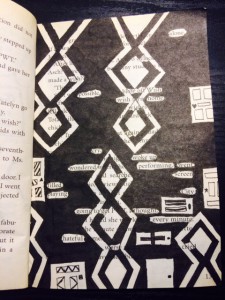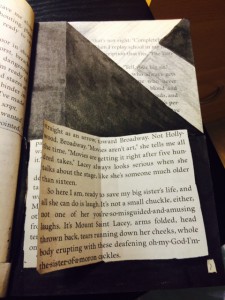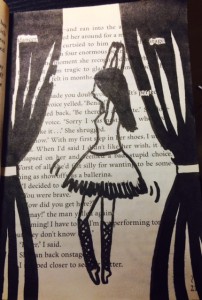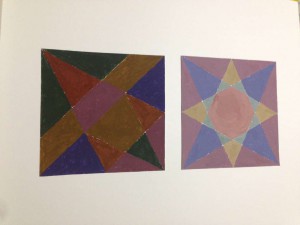This exhibit is presented by Ayano Morishima, who was born and raised in Tokyo, Japan, then moved to New York, where she now lives and studies. She was inspired by Tom Phillips’s work, Humument of transforming a used book into an art and poetry project. Morishima then created, La Fay-Vaile a new name she picked out from the original book she used for her project. She also changed the theme of a book to dark wonderland to show the difference from the original theme, Wish. She was also inspired by the original creator of Alice in Wonderland by Charles Lutwidge Dodgson under the pseudonym, Lewis Carroll in 1865. The three design Morishima created, Gates to Wonder, Book to Wonder, and Dreams to Wonder are from the book that represents to the theme the most and an message about how anyone can rewritten a destiny of the book. Though Morishima’s knowledge and techniques from her studies in COMD 1100 and ENG 1101, college courses that is part of Learning Community: Ways of Seeing, it helped her to be able to create this project. To create her designs, she used her technique in using ink brush pen, x-acto knife, old book and folding to show the viewers, the new kind of story that unfolds.
For the first design, Morishima title the design, Gates to Wonder. Because of multiple doors of the design, indicating a way to the wonderland. A starting point that everyone must encounter. She used the ink brush pen to make many repetition of connected diamonds to indicate a chandelier also, blocking out most of the text in the book to show how visible text are connected to the picture that is shown as a ground. Each words representing the meaning behind the design, such as went, door, worse, cry, wondered, etc. In addition, used figure and ground technique to show the viewers where exactly to see; in this case, the shapes of the ground shows more vividly since the black ink, the figure blocks out other negative space.
Down into the rabbit hole; the second design, Book to Wonder leads the viewers to go though the door to read a little book that came from the concept of the original, Alice in Wonderland. She used x-acto knife to cut open a block of text at the bottom of the page and glued only in the middle. By doing this, she wants the viewers to see that there is a book in a book. Same as the first design, she used the technique of figure and ground, showing the ground to block other negative space. In addition, by folding the corner to the right top, it shows the next design that shows the technique of a chromatic gray; grays that exhibit a subtle, but visible hue; created by adding larger amounts the complement and white.
Dreams to Wonder is a design that was created to show “the after math of Wonderland”. Story goes as the darkness in wonderland was finally came to the end. Many would think that the ballerina could be Alice, however being the character in the original story, Morishima completely disconnected the characters from her project. The ballerina indicates a spirit that it stabilizes the wonders in the wonderland. She also used ink brush pen to create curtains on the right and left sides to show that she is on a stage, and the visible words that fits with the story of the page, such as dancer, moment, felt, perfect, and choice.
Ayano Morishima, made this project from her understanding in COMD 1100 and ENG 1101, college course she is taking in New York, where she lives. She made this mainly to attract people who are interested in creating their own story. It conveys though out each pieces of art work and detailed design, where it tells the message in the theme. Single page contains a message where Morishima’s story that she made though out the art she loves, she wants the viewers to understand that stories can be can be rewritten to make new ones. Even characters, make them have their own destiny with out following the original story.










